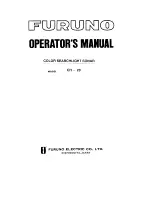
451253/A
29
Flow noise
The upper water layers of the sea contain a myriad of small air bubbles created by the
breaking waves. When the hull moves through water it will cause a disturbance, and this
will generate friction. The friction zone is called the
flow boundary layer
. The flow in
this boundary layer may be
laminar
or
turbulent
.
• The
laminar
flow is a nicely ordered, parallel movement of the water.
• The
turbulent
flow is a disorderly flow pattern, full of eddies.
A
Turbulent flow
B
Laminar flow
C
Air bubbles
Air bubbles absorb and reflect the sound energy, and they may in worst cases block the
sound transmission altogether.
The boundary layer increases in thickness when it becomes turbulent. The boundary
layer is thin in the forward part of the vessel hull, and increases as it moves aft. The
thickness depends on ships speed and on the roughness of the hull. All objects sticking
out from the hull, or dents in the hull, will disturb the flow and will increase the thickness
of the boundary layer. When the flow speed is high, the turbulence can be violent enough
to destroy the integrity of the water. Small voids or cavities in the water will occur and
this is called cavitation.
Rattle noise
Rattle noise may be caused by loose objects in the vicinity of the transducer, like fixing
bolts. The rattle may also come from loose objects inside the hull.
Interference
Interference from other hydroacoustic equipment on board the same vessel may be an
annoying source of disturbance. Unless the same frequency is used for more than one
piece of equipment only the transmitted pulse will contribute to the interference.
In physics, interference is the phenomenon in which two waves superpose each
other to form a resultant wave of greater or lower amplitude. Interference usually
refers to the interaction of waves that are correlated or coherent with each other,
either because they come from the same source or because they have the same or
Summary of Contents for SBP 29
Page 1: ...451253 A November 2019 Kongsberg Maritime AS SBP 29 Sub bottom profiler Installation Manual ...
Page 111: ...451253 A 111 Figure 12 862 216859 Drawing files ...
Page 112: ...112 451253 A Figure 13 307904 SBP 29 Installation Manual ...
Page 113: ...451253 A 113 Figure 14 862 218001 Drawing files ...
Page 114: ...114 451253 A Figure 15 871 219193 SBP 29 Installation Manual ...
Page 115: ...451253 A 115 Figure 16 871 219201 Drawing files ...
Page 116: ...116 451253 A Figure 17 388168 SBP 29 Installation Manual ...
Page 117: ...451253 A 117 Figure 18 871 219187 Drawing files ...
Page 118: ...118 451253 A Figure 19 821 219199 SBP 29 Installation Manual ...
Page 119: ...451253 A 119 Figure 20 388235 Drawing files ...
Page 120: ...120 451253 A Figure 21 871 219198 SBP 29 Installation Manual ...
Page 121: ...451253 A 121 Figure 22 388148 Drawing files ...
Page 122: ...122 451253 A Figure 23 315550 SBP 29 Installation Manual ...
Page 123: ...451253 A 123 Figure 24 430751 Drawing files ...
Page 124: ...124 451253 A Figure 25 871 212984 SBP 29 Installation Manual ...
Page 125: ...451253 A 125 Figure 26 407070 Drawing files ...
Page 126: ...126 451253 A Figure 27 448231_1A SBP 29 Installation Manual ...
Page 127: ...451253 A 127 Figure 28 427512 Drawing files ...
Page 128: ...128 451253 A Figure 29 435680 SBP 29 Installation Manual ...
Page 129: ...451253 A 129 Figure 30 444783 Drawing files ...
Page 151: ......
Page 152: ... 2019 Kongsberg Maritime ...
































